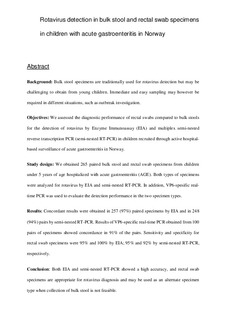| dc.contributor.author | Gibory, Moustafa | |
| dc.contributor.author | Haltbakk, Ildri | |
| dc.contributor.author | Flem, Elmira | |
| dc.contributor.author | Vainio, Kirsti | |
| dc.contributor.author | Valcarcel Salamanca, Beatriz | |
| dc.contributor.author | Størdal, Ketil | |
| dc.contributor.author | Nordbø, Svein Arne | |
| dc.contributor.author | Jakobsen, Kirsti | |
| dc.contributor.author | Haarr, Elisebet | |
| dc.contributor.author | Dudman, Susanne Gjeruldsen | |
| dc.date.accessioned | 2018-09-27T07:30:45Z | |
| dc.date.available | 2018-09-27T07:30:45Z | |
| dc.date.created | 2017-11-10T13:17:05Z | |
| dc.date.issued | 2017 | |
| dc.identifier.citation | Journal of Clinical Virology. 2017, 97 50-53. | nb_NO |
| dc.identifier.issn | 1386-6532 | |
| dc.identifier.uri | http://hdl.handle.net/11250/2564843 | |
| dc.description.abstract | Background
Bulk stool specimens are traditionally used for rotavirus detection but may be challenging to obtain from young children. Immediate and easy sampling may however be required in different situations, such as outbreak investigation.
Objectives
We assessed the diagnostic performance of rectal swabs compared to bulk stools for the detection of rotavirus by Enzyme Immunoassay (EIA) and multiplex semi-nested reverse transcription PCR (semi-nested RT-PCR) in children recruited through active hospital-based surveillance of acute gastroenteritis in Norway.
Study design
We obtained 265 paired bulk stool and rectal swab specimens from children under 5 years of age hospitalized with acute gastroenteritis (AGE). Both types of specimens were analyzed for rotavirus by EIA and semi-nested RT-PCR. In addition, VP6-spesific real-time PCR was used to evaluate the detection performance in the two specimen types.
Results
Concordant results were obtained in 257 (97%) paired specimens by EIA and in 248 (94%) pairs by semi-nested RT-PCR. Results of VP6-specific real-time PCR obtained from 100 pairs of specimens showed concordance in 91% of the pairs. Sensitivity and specificity for rectal swab specimens were 95% and 100% by EIA; 95% and 92% by semi-nested RT-PCR, respectively.
Conclusion
Both EIA and semi-nested RT-PCR showed a high accuracy, and rectal swab specimens are appropriate for rotavirus diagnosis and may be used as an alternate specimen type when collection of bulk stool is not feasible. | nb_NO |
| dc.language.iso | eng | nb_NO |
| dc.publisher | Elsevier | nb_NO |
| dc.rights | Attribution-NonCommercial-NoDerivatives 4.0 Internasjonal | * |
| dc.rights.uri | http://creativecommons.org/licenses/by-nc-nd/4.0/deed.no | * |
| dc.title | Rotavirus detection in bulk stool and rectal swab specimens in children with acute gastroenteritis in Norway | nb_NO |
| dc.type | Journal article | nb_NO |
| dc.type | Peer reviewed | nb_NO |
| dc.description.version | acceptedVersion | nb_NO |
| dc.source.pagenumber | 50-53 | nb_NO |
| dc.source.volume | 97 | nb_NO |
| dc.source.journal | Journal of Clinical Virology | nb_NO |
| dc.identifier.doi | 10.1016/j.jcv.2017.10.017 | |
| dc.identifier.cristin | 1512967 | |
| dc.description.localcode | © 2017. This is the authors’ accepted and refereed manuscript to the article. Locked until 1.11.2018 due to copyright restrictions. This manuscript version is made available under the CC-BY-NC-ND 4.0 license http://creativecommons.org/licenses/by-nc-nd/4.0/ | nb_NO |
| cristin.unitcode | 194,65,15,0 | |
| cristin.unitname | Institutt for klinisk og molekylær medisin | |
| cristin.ispublished | true | |
| cristin.fulltext | original | |
| cristin.fulltext | postprint | |
| cristin.qualitycode | 1 | |

